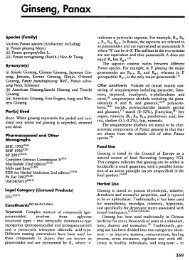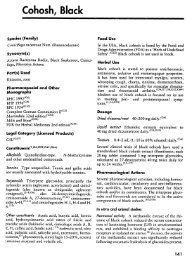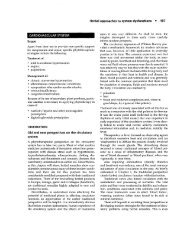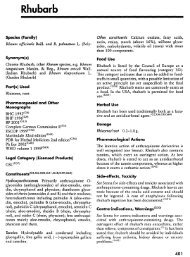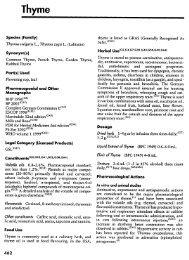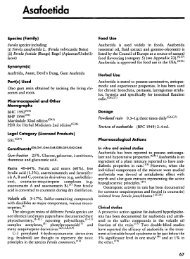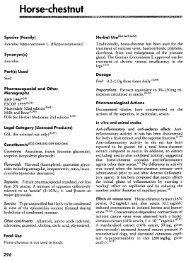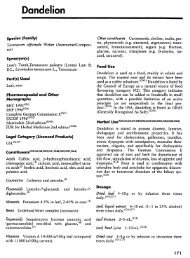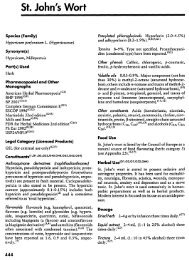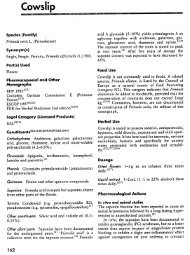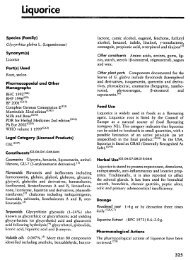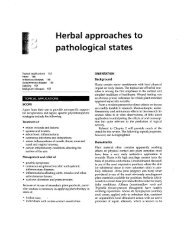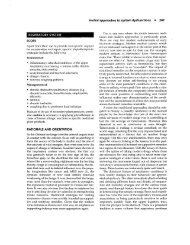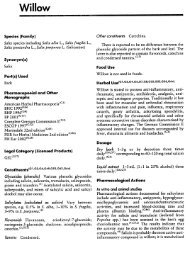Valerian
Valerian
Valerian
You also want an ePaper? Increase the reach of your titles
YUMPU automatically turns print PDFs into web optimized ePapers that Google loves.
<strong>Valerian</strong> 469<br />
Dosage<br />
Dried rhizome/root 1- g<br />
by infusion or decoction<br />
up to three times daily . (G6<br />
Tincture -5mL (1 :5 ; 70% ethanol) up to three<br />
times daily ; (G6,G50) 1- mL, once to several times<br />
daily. (G )<br />
Extracts Amount equivalent to 2- g drug, once to<br />
several times daily-, ) 2-6 mL of 1 : 2 liquid extract<br />
daily. (GSO)<br />
Doses given in older texts vary . For example :<br />
<strong>Valerian</strong> Liquid Extract (BPC 196 ) 0 . -1 .0 mL ;<br />
Simple Tincture of <strong>Valerian</strong> (BPC 1949) 4-8 mL ;<br />
Concentrated <strong>Valerian</strong> Infusion (BPC 196 ) 2-4mL .<br />
Clinical trials investigating the effects of valerian<br />
extracts on sleep parameters have used varying<br />
dosages, for example, valerian extract 400 mg/day<br />
(drug : extract ratio of :1) (1 ) to 1215 mg/day<br />
(drug : extract ratio of S to 6 : 1) . (14)<br />
Pharmacological Actions<br />
It remains unclear precisely which of the constituents<br />
of valerian are responsible for its sedative properties<br />
. (' ) Attention had focused on the volatile oil, and<br />
then the valepotriates and their degradation products,<br />
as the constituents responsible . However, it appeared<br />
that the effects of the volatile oil could not account for<br />
the whole action of the drug, and the valepotriates,<br />
which degrade rapidly, are unlikely to be present in<br />
finished products in significant concentrations . Current<br />
thinking is that the overall effect of valerian is due<br />
to several different groups of constituents and their<br />
varying mechanisms of action . Therefore, the activity<br />
of different valerian preparations will depend on their<br />
content and concentrations of several types of constituent.<br />
(4) One mechanism of action is likely to involve<br />
increased concentrations of the inhibitory transmitter<br />
GABA in the brain . Increased concentrations of<br />
GABA are associated with a decrease in CNS activity<br />
and this action may, therefore, be involved in the<br />
reported sedative activity .<br />
In vitro and animal studies<br />
Sedative properties have been documented for valerian<br />
and have been attributed to both the volatile oil<br />
and valepotriate fractions . (15 .16) Screening of the<br />
volatile oil components for sedative activity concluded<br />
valerenal and valerenic acid to be the most<br />
active compounds, causing ataxia in mice at a dose of<br />
50mg/kg by intraperitoneal injection! 151 Further<br />
studies in mice described valerenic acid as a general<br />
CNS depressant similar to pentobarbitone, requiring<br />
high doses (100mg/kg by intraperitoneal injection)<br />
for activity . (17) A dose of 400 mg/kg resulted in muscle<br />
spasms, convulsions and death ."' ) Valerenic acid was<br />
also reported to prolong pentobarbitone-induced<br />
sleep in mice, resulting in a hangover effect. Biochemical<br />
studies have documented that valerenic acid<br />
inhibits the enzyme system responsible for the central<br />
catabolism of GABA .M 18) An aqueous extract of roots<br />
and rhizomes of V officinalis (standardised to 55 mg<br />
valerenic acids per 100 g extract) inhibited the uptake<br />
and stimulated the release of radiolabelled GABA in<br />
isolated synaprosomes from rat brain cortex . (19,20)<br />
Further work suggested that this aqueous extract of<br />
valerian induces the release of GABA by reversal of the<br />
GABA carrier, and that the mechanism is Na' dependent<br />
and Ca t, independent . (20) The extract contained<br />
a high concentration of GABA (about 5 mmol/L)<br />
which was shown to be sufficient to induce the release<br />
of radiolabelled GABA by this type of mechanism . (21)<br />
Aqueous and hydroalcoholic (ethanol) extracts of<br />
valerian root displaced radiolabelled muscimol binding<br />
to synaptic membranes (a measure of the influence<br />
of drugs on GABAA receptors) . However, valerenic<br />
acid (0 .1 mmol/L) did not displace radiolabelled muscimol<br />
in this model .' 22) Other in vitro studies using rat<br />
brain tissue have shown that hydroalcoholic and<br />
aqueous total extracts of V. officinalis root, and an<br />
aqueous fraction derived from the hydroalcoholic<br />
extract, show affinity for GABA A receptors, although<br />
far lower than that of the neurotransmitter itself . )<br />
However, a lipophilic fraction of the hydroalcoholic<br />
extract, hydroxyvalerenic acid and dihydrovaltrate<br />
did not show any affinity for the GABAA receptor in<br />
this model .<br />
The effects of valerian extracts on benzodiazepine<br />
binding to rat cortical membranes have also been<br />
explored . Very low concentrations of ethanolic<br />
extract of V officinalis had no effect on radiolabelled<br />
flunitrazepam binding in this model, although<br />
concentrations of 10 -10 to 10 -8 mg/mL increased<br />
radiolabelled flunitrazepam binding with an EC50<br />
of 4 .1 x 10 -10 mg/mL . (24) However, flunitrazepam<br />
binding was inhibited at higher concentrations<br />
(0 .5-7 .0 mg/mL) of valerian extract (IC50<br />
4 .82 x 10 -1 mg/mL) . In other investigations, valerian<br />
extract potentiated radiolabelled GABA release<br />
from rat hippocampal slices, and inhibited synaptosomal<br />
GABA uptake, confirming the effects of valerian<br />
extract on GABA A receptors . (24)<br />
CNS-depressant activities in mice following intraperitoneal<br />
injection have been documented for the<br />
valepotriates and for their degradation products,<br />
although activity was found to be greatly reduced<br />
following oral administration . (21) A study explored<br />
the effects of a mixture of valeporriates on the behaviour<br />
of diazepam-withdrawn male Wistar rats in the



